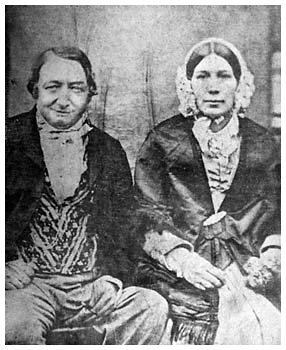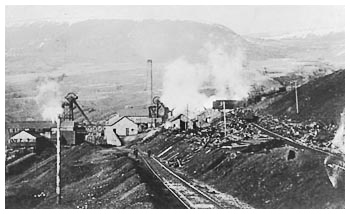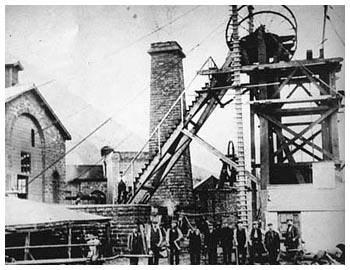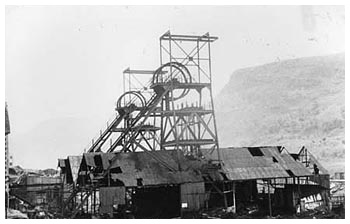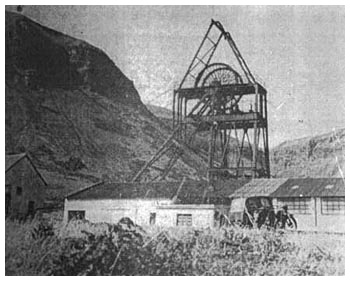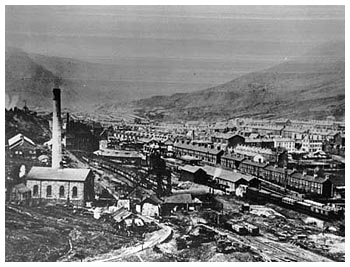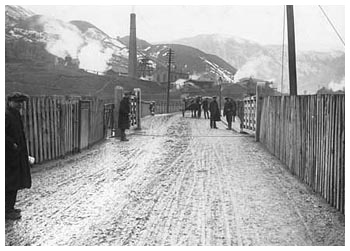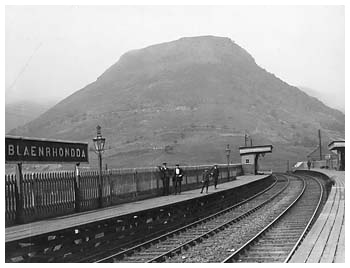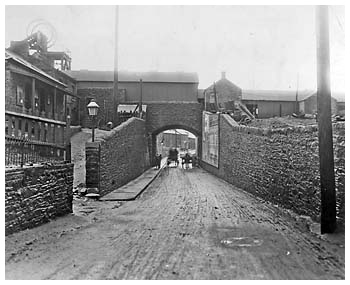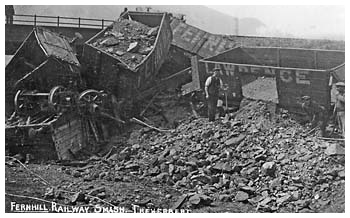
| Treherbert | |
William and Catherine Davies of Cwmsaebren Farm |
Prior to industrialisation, the villages we know today as Treherbert, Tynewydd, Blaenrhondda and Blaencwm consisted of a number of isolated farms and a small number of scattered homesteads. The area was sparsely populated and as the Revd. Lewis described in his 1959 outline History of the Parish of Treherbert, ' lay completely off the beaten track, at the head of a secluded, pastoral valley, which had preserved all the characteristics of rural charm'. Although there is evidence of human habitation going way back to Celtic times the population of this district remained small, in 1841 there were only 218 people residing in the 'Middle hamlet of Treherbert'. However by 1861 this had increased by 500% to 1,203. The development of these villages, and indeed to a certain extent all of the Rhondda depends largely on one event, namely the sinking of the first steam-coal pit at Cwm- Saebren (Treherbert) in 1855.
|
| Despite this in April 1853 the Upper 4ft seam of steam coal was struck at a depth of 125 yards, and production was begun in 1855. Incidentally it was in January of this year the first recorded use of the name Treherbert was seen in the Parish records, commemorating one of the family names of the Marquess of Bute. The first 38 wagons of steam coal were transported from the newly extended Taff Vale Railway station at Gelligaled (Ystrad) to Cardiff on the 21st December that year. From this time in the mid 1850's the expansion of the villages at the top end of the Rhondda Fawr really began and the building of the first rows of houses took place, the first being at Bute Street, Dumfries Street, and Baglan Street. | |
| Treherbert Coal Industry | |
The following are brief histories of some of the main mines in the Treherbert, Blaenrhondda, Blaencwm area, but is not intended as a comprehensive listing of all the workings in the area. |
|
| Abergorky (Abergorchi) Colliery - Treherbert | |
A small level existed here in the early 1800's however it was after the Bute pit was sunk and an influx of coal speculators came to the upper Rhondda that this mine was expanded and fully exploited. In September 1859 a level was driven to the Rhondda No.3 seam by a partnership of Houghty Huxham, Thomas Hopkin and William Morgan. This level was subsequently purchased by H. Insole for £7,000., in 1862 who sunk a shaft to the steam coal seams, and then by Bunyeat, Brown and Company who purchased the colliery in 1874. It was finally purchased by the Ocean Coal Company in 1926, but was no longer being worked when the mines were nationalised in 1947. |
Abergorky Colliery circa 1900 |
| Bute Merthyr Colliery (Treherbert) | |
Bute Merthyr Colliery circa 1885 |
Sunk in 1851 it reached the Upper-Four- Feet seam at a depth of 125 yards in 1853, the upcast was sunk between 1853 and 1854. The Bute Estate leased it out in 1857 to company that failed in 1859 when it lay idle for nine months. In 1862 W.S.Clark decide to supervise production himself on behalf of the Bute Estate and production increased rapidly. By 1869 production had almost doubled, and the pit was deepened striking the Two-Feet-Nine seam, the Six Feet seam, and the Nine-Feet seam. United National Collieries purchased the colliery in 1915, and control was subsequently passed to the Ocean Coal Company in 1926. |
Fernhill Collieries |
|
Fernhill consisted of a series of five pits and levels, which included the North Dunraven pit. Ebenezer Lewis sank the FERNHILL NO.1 and 2 pits in 1869. These reached the six feet seam in 1871 and he sold them to a partnership of Messrs. Crowley, John and Oldroyd that same year. They subsequently sold the pits in 1877 to George Watkinson and Sons, who also bought the North Dunraven (Blaenrhondda) Pit in 1893 and merged this pit with Fernhill Colliery. Watkinson then formed a public company called Fernhill Collieries Limited. The Cambrian Trust Limited later absorbed this company in 1910, and by 1913 the combined manpower of these pits numbered over 1,700 men. |
Fernhill No.1 and No. 2 pits |
| In 1920 the last of the Fernhill pits to be sunk was the NO.5 and the company became part of the Welsh Associated Collieries Limited which in turn merged with Powell Duffryn in 1935, becoming Powell Duffryn Associated Collieries Limited who controlled the Collieries until nationalisation in 1947. After Nationalisation Fernhill was placed in the National Coal Boards' South Western Division No.3 area Group 4. At that time the colliery employed over 1,000 men and worked the Four Feet, Nine-Feet, New and Two-Feet seams. Fernhill was merged with Tower Colliery, Hiwaun in 1966 and its output was raised at Tower., the Fernhill section was finally closed in 1978. | |
Glen Rhondda Colliery (Blaencwm) |
|
Glen Rhondda Colliery circa 1963 |
This colliery was opened in 1911 by the Glenavon Garw Collieries Limited, a member of the South Wales Coal Owners association, and was served by the Rhondda and Swansea Bay railway. It consisted of two levels a slant and a pit and during its lifetime employed anywhere between 200 and 500 men, producing both house and manufacturing coals. After nationalisation the colliery was placed in the National Coal Boards' South Western division's, NO.3 Area, Group 4 and at that time No.s 1 and 2 pits had a combined manpower of over 450 men, whilst the NO.2 level employed approximately 70 men. The no.2 level had closed by 1954 and the colliery as a whole was closed by the National coal Board in 1966. |
| Lady Margaret Colliery (Treherbert) | |
| This was one of the earliest pits in the Upper Rhondda, sunk by the Marquess of Bute in 1853. It was served by the newly extended Taff Vale Railway, and the colliery sidings had a capacity for 160 full, 114 empty and 45 other wagons. It was sunk to the Upper Four foot seam and also worked the Two-Feet-Nine, Four-Feet, and Six-Feet seams before their abandonment in 1909. United National Collieries Limited purchased the colliery, along with Bute Merthyr, in 1915 and in 1926 Ocean Coal Company gained a controlling interest in this company. When nationalised in 1947 Lady Margaret was only used for pumping and ventilation purposes. |
Lady Margaret Colliery circa 1916 |
| Tydraw Colliery (Blaencwm) | |
Tydraw Colliery can be seen in the background |
This pit was originally known as Dunraven Colliery after its original owners, the Dunraven United Collieries Limited, formed by Thomas Joseph. This company went into liquidation in 1866 after finding the Two-Feet-Nine seam in 1865. It lay idle until 1872 when it was purchased by Watts and Company. It was served by the Taff Vale railway and had a sidings capacity in 1897 of over 340 wagons. When the Cory Brothers purchased it in 1913 it employed 806 men. It remained in their hands until Nationalisation in 1947 when it was placed in the National Coal Board's, South Western Division's, NO.3 Area, NO.4 Group at which time it employed nearly 450 men. The mine was closed in January 1959. |
| Treherbert Transport | |
| Prior to the sinking of the Bute Merthyr Pit, transport in the upper reaches of the Rhondda was what you would expect in a small rural area in the early 1800's. There was no railway link and the public highway consisted mainly of rough tracks and innumerable bridle paths, access to neighbouring valleys was through a ridgeway meeting the Neath/Aberdare road. Means of crossing the river at this time was via two fords, Rhyd-Y-Cwm, above Blaenrhondda, and Rhyd Tonllwyd at Treherbert. The industrial development of this area was intrinsically linked to the development of transport links to the area, ending its rural isolation and making it a centre of industrial activity. One of the major factors governing the development in the area was the need for the Taff Vale Railway to extend its operations, and hence its profits, into the area of the Upper Rhondda. In the 1840's the railway ran as far as Dinas, but speculation was rife as to the mineral wealth contained in the Upper Rhondda. As such the Taff Vale Railway secured the powers to extend their line as far as Tynewydd in 1846, however the cost of such an enterprise would have been prohibitive but for the value of the mineral resources in this part of the valley. |
Blaenrhondda station platform |
| Therefore the Company offered a £500 reward to anyone who would sink a pit at a depth of more than 120 yards in the upper reaches of the Rhondda Fawr. The Bute Merthyr pit achieved this when a seam of steam coal was proved at 125 yards in 1853. The effect on transportation was immediate, with the Taff Vale Railway at first extending its line to Gelligaled in Ystrad Rhondda and thence on to Bute Merthyr in Treherbert in 1856. This had an immense effect on the feasibility of large-scale mining operations in the area, no longer did equipment have to be carried by horse wagon eight miles up the valley along unsatisfactory roads. Also the coal once mined did not have to be carried down the valley in the same way. As such the whole process was speeded up and therefore more efficient and of course most importantly for those concerned, more profitable. It has to be noted that at this time railways in this area were seen as being for primarily freight operations, it was not until January 1863 the first passengers were carried into Treherbert station. Another major railway link that had great influence on this area was the creation of the Rhondda and Swansea Bay Railway that opened the top end of the Valley and made it accessible to the Areas of Neath and Swansea. The Rhondda and Swansea Bay Company was incorporated in 1882 with the intention of linking the Upper Rhondda to the ports in Swansea Bay, and as they saw it emancipating the coalfield from the monopoly of the Taff Vale Railway. The outstanding engineering feat of this railway was the creation of the tunnel at Blaenrhondda through to Blaengwynfi, which at nearly three and a half thousand yards long is the largest in Wales, and which at the height of construction employed upwards of 1,100 men. The railway was never the success it was hoped that it would be, and never succeeded in breaking the grip of the Taff Vale Railway. One by-product of its existence was the way it made accessible to the population of the Upper Rhondda the area west of the Rhondda, particularly popular during the summer months when trainloads of day-trippers made for the beaches of Aberavon and Swansea. |
|
Ynysfieo Bridge circa 1900 |
As stated previously the roads of this area were woefully inadequate for the influx of people that came to the area to work in the newly created coal industry. It was up to individual colliery owners to initiate a road-building programme, and in this respect the Bute Estate was at the forefront of developments, and in the early 1860's called for a length of road 50ft wide from Treherbert to Pontypridd. This plan never came to fruition but was carried out by the Bute Estates themselves from Treherbert to Treorchy. Later in the 1920's the Rhigos road, then known as the New Road, was built by the local council thus linking the top end of the valley to the Cynon and Neath valleys. |
Early road traffic consisted of mainly of hansom cabs, brakes and waggonettes but in the 1860's two horse omnibus services were set up, running between Treorchy and Treherbert. This service was extended in the 1870's with three services daily between Treherbert and Ystrad. In April 1906 the Rhondda Tramways Company was formed leading to the first electric tramcar into Treherbert in 1908. The trams were substituted for buses in the 1930's and in 1931 the first bus ran from Treherbert to Cardiff. Thus in the space of less than eighty years the Upper Rhondda had been transformed from a sleepy, isolated parish, largely unchanged for hundreds of years, to a bustling industrial town with links to all of South Wales. |
Fernhill rail smash |
